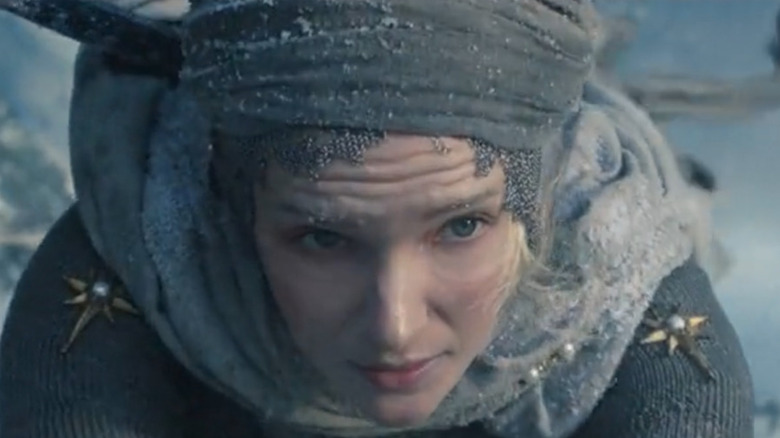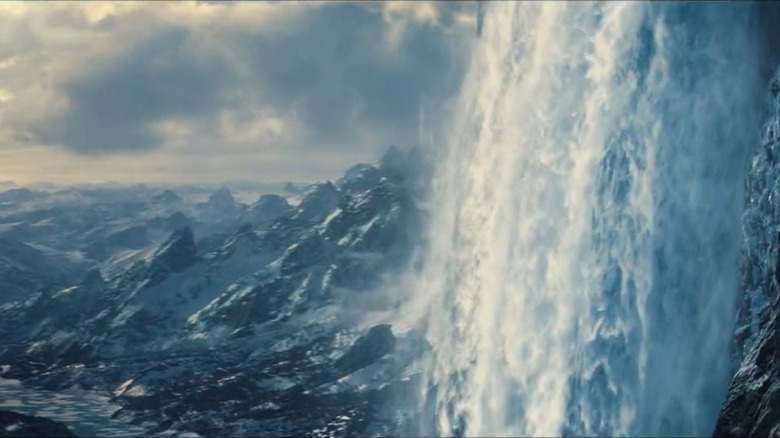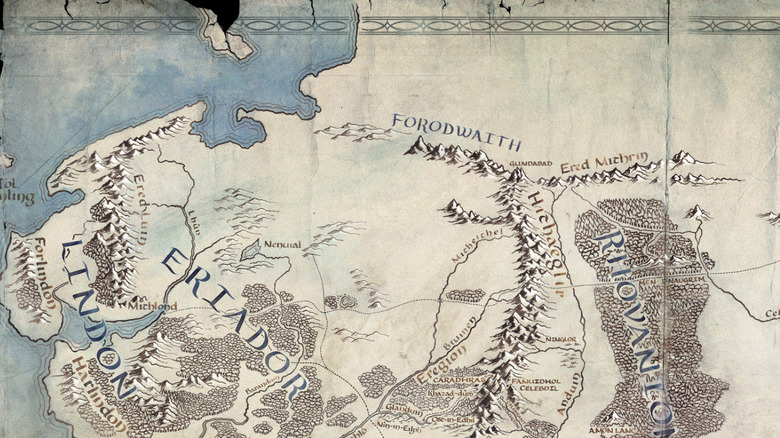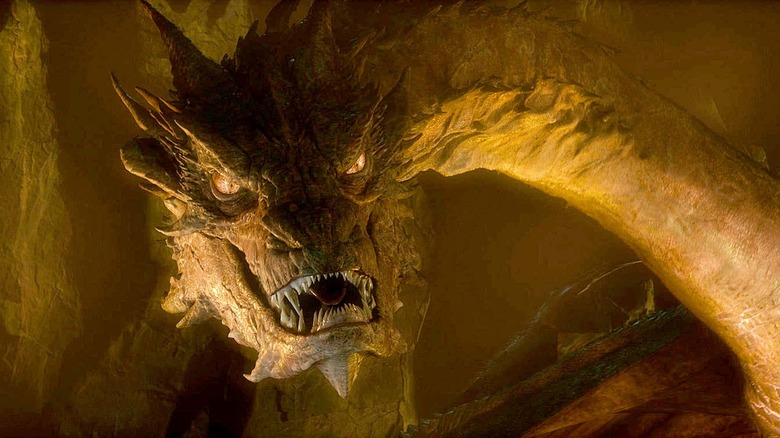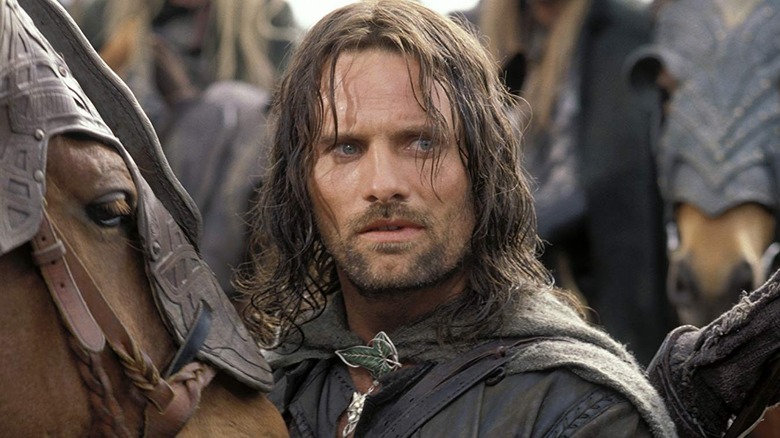The Rings Of Power's Forodwaith Explained
In the first "The Lord of the Rings: The Rings of Power" trailer, we see a stunning shot of Galadriel scaling a cliff in the middle of a turbulent, chilly wasteland covered in snow and ice. In a breakdown of the trailer after the fact, it was made clear that the location is an area of Middle-earth known as the Forodwaith or "Northern Waste."
The reveal naturally spawns the easy follow-up question: what is the Forodwaith? The term "northern waste" only shows up once in "The Lord of the Rings" story proper. In "The Fellowship of the Ring" book, Frodo writes a song about Gandalf after the Wizard falls in battle with the Balrog. In that song, the Hobbit adds the words "From Wilderland to Western shore, from northern waste to southern hill ..."
That's it — at least until you get to the Appendices of the Return of the King. There, in those precious, dense, information-filled endnotes, we get quite a bit more information about this fascinating frozen area of Middle-earth.
Since "Rings of Power" is clearly going into the Forodwaith, we thought we'd join them via a breakdown of what the Forodwaith is, who lives there (yes, people permanently live in that ice-block-of-a-country) and what other famous figures have traveled there before the "Rings of Power" team chose to send Morfydd Clark's young Galadriel into the treacherous region.
The Northern Waste
The word "Forodwaith" is also called the Northern Waste in most accounts of J.R.R. Tolkien's writings. The only exception is one instance in the introduction to the book "Unfinished Tales," where Tolkien's son, Christopher, says that in one version of his father's writings the title is condensed to the single word "Northerland." In either case, the Forodwaith is a frozen chunk of property away in the north of Middle-earth proper. If you follow a Middle-earth map to the top of the Misty Mountain range (that "spine" running up the middle of the map), Forodwaith is just beyond the top where the range splits.
This area is just north of Mount Gundabad, the primary stronghold of the Witch-king when he rules his realm of Angmar hundreds of years before "The Lord of the Rings" takes place. It's also just north of the eastern spur of mountains called the Ered Mithrin or "Grey Mountains." These are connected to the Misty Mountains and located to the north of the Lonely Mountain. (We know, it's a lot of geography, but this all ties into why this area is important.)
The Northern Waste itself is a bitterly cold area. This is because it's located near the ancient remains of Utumno, the original fortress of the Dark Lord, Morgoth (Sauron's original master). While that stronghold was destroyed long before the era of "The Rings of Power," the bone-chilling might of its master continues to grip the region after its downfall, turning the area into a perpetually cold place to live.
All the way to the west (left on the map) of the Northern Waste is the Cape of Forochel. This is a giant bay along the ocean where the bulk of the people of the land lives.
The Forodwaith are also a people
While the word Forodwaith refers to a region, it also is synonymous with the people who live there. In fact, Tolkien clarifies that the inhabitants give the land its name, Forodwaith, which translates as "people of the North." The Forodwaith live in the north for a long time and are cryptically referred to as men of far-off days, leaving the reader to wonder how "far off" those days might have been. There's plenty of reason to believe these men could exist as far back as the Second Age and the "Rings of Power" story, but it isn't definitely stated.
Regardless, by the time we meet them in Tolkien's writings, they're the remnants of the original crew, a group called the Lossoth or the Snowmen of Forochel. In the appendix to "The Return of the King," the Lossoth are called "a strange, unfriendly people, remnant of the Forodwaith, Men of far-off days, accustomed to the bitter colds of the realm of Morgoth. The Lossoth lead bitterly cold lives — no, seriously. They live in literal snow houses and don't need wheeled transportation since all of their carts are sled-bound. They're even legendary ice skaters who strap bones to their feet to glide over the ice.
Lossoth culture feels tribal and primitive. They lean heavily on their gut instincts and spirituality. They utter prescient statements (more on that in a minute) and can smell danger in the wind, much like the Drúedain who live near Minas Tirith.
As an interesting aside, in some of his earliest writings, Tolkien also used the word "Forodwaith" to refer to Vikings. While the two groups don't directly connect, it's clear that he wanted to integrate some form of these Men of the North into his world from very early on.
There are Dragons in the Forodwaith
While there are inhabitants in the Forodwaith, there are other less savory creatures, too. Of particular note, more than once, it's mentioned that Dragons live in the area. Tolkien says that the wasted lands beyond the Grey Mountains (north of the Lonely Mountain) were inhabited by dragons, specifically mentioning cold-drakes — that is, dragons who don't breathe fire — that dwell there.
Of course, there must be firedrakes living there, too, since this is the area where Smaug hails from before he heads south and evicts the Dwarves so he can claim the Lonely Mountain as a new home — which, shifting from a freezing wasteland to a cozy Dwarven fortress seems like a pretty good upgrade, all things considered. Anyway, in "The Hobbit," Thorin also explains that "There were lots of dragons in the north in those days..." speaking of the time before Smaug headed south to attack his people.
Whether or not the same monsters would have been present thousands of years earlier in the Second Age (during "Rings of Power") isn't stated. However, Dragons are present in the War of Wrath at the end of the First Age, and it wouldn't be a stretch to assume that they would continue to be a pest and a threat in the northern regions of Middle-earth between that time and later in the Third Age when we hear about them again. This would mean they could easily factor into the "Rings of Power" storyline.
The Last King in the Northern Waste
The last bit about the Forodwaith that we'll mention here is that one of Aragorn's ancestors also has a pretty epic (and tragic) adventure there. We're talking about the Ranger's ancestor, Arvedui, the Last King of Arthedain.
Of course, any time a character's cognomen is "last king," it isn't a good sign. In this case, Arveui starts as the king of the splinter kingdom of Arthedain (a remnant of Gondor's sister kingdom of Arnor in Northern Middle-earth). At one point, he gets tangled up on the losing side of a fight with the Witch-king of Angmar, who invades his kingdom and crushes it. The king of the land flees north with a handful of his vassals ...right into the Northern Waste.
There, it says that he first hides in some old tunnels of abandoned dwarf mines, but hunger drives him to seek the help of the nearby locals. Who are they? Why, the Forodwaith, of course. They're skeptical of this ragged king and his followers, but they build them snow huts and give them some food. After some time spent twiddling their thumbs, an Elven ship arrives and carries the king and his people away.
Before that happens, though, the chief of the Forodwaith prophesies that Arvedui shouldn't get on the ship. The king ignores the advice, sails away, and is drowned in an icy storm soon afterward. Interestingly, he leaves his ring behind in gratitude for the help of the Snowmen. That ring ends up being the Ring of Barahir, a very important heirloom that is ransomed by Arvedui's people later on and eventually finds its way onto the hand of none other than Aragorn himself.
